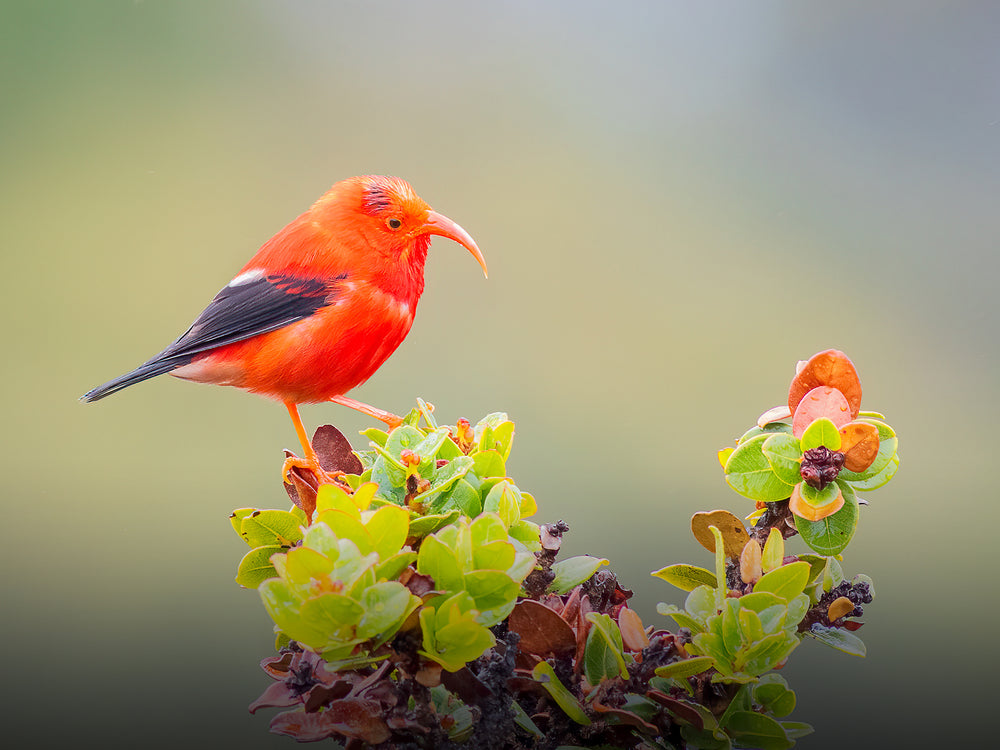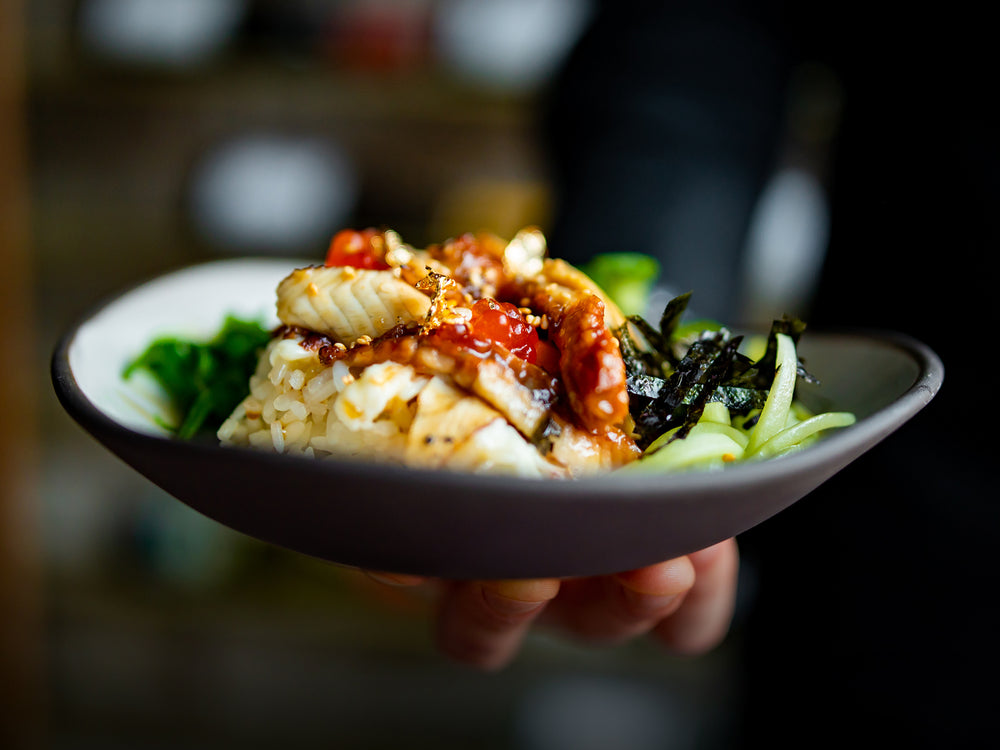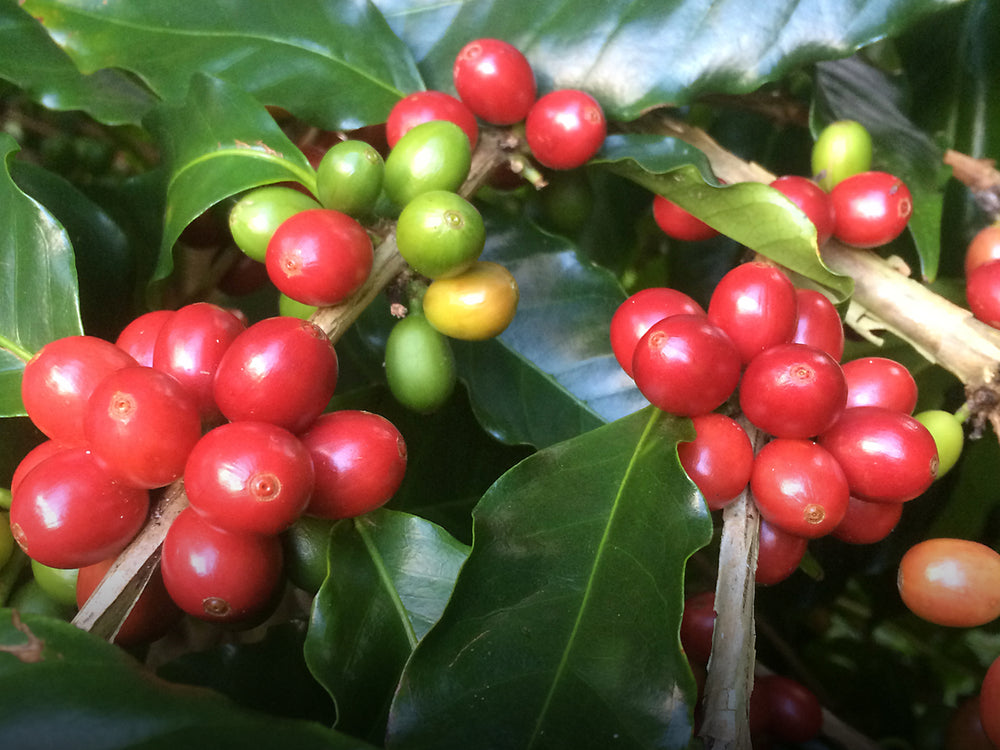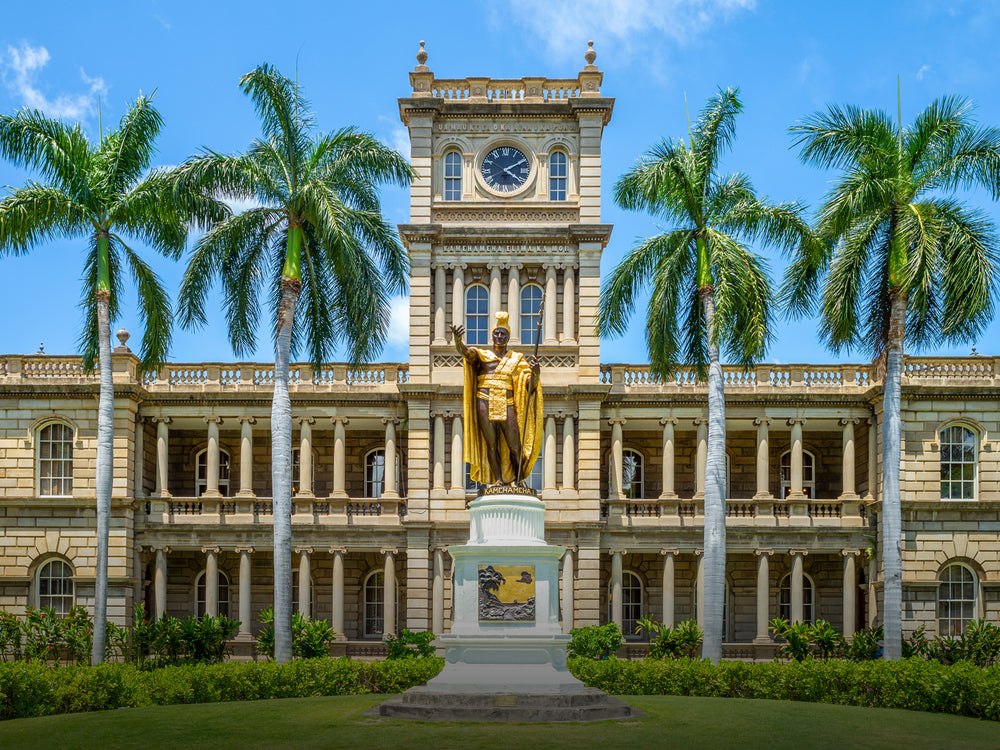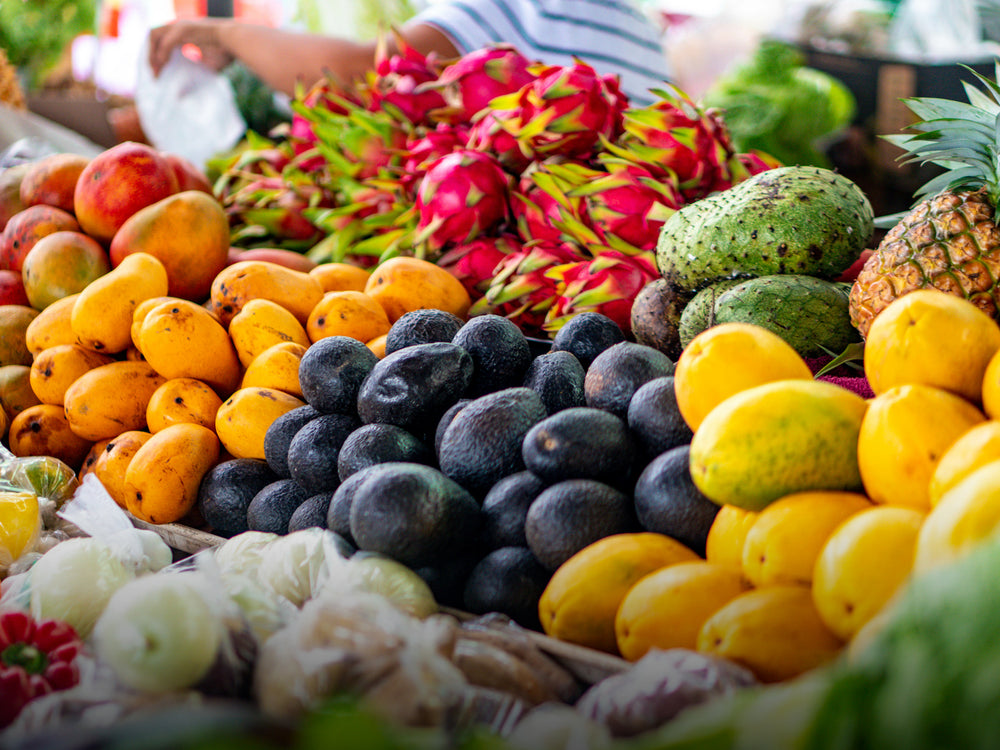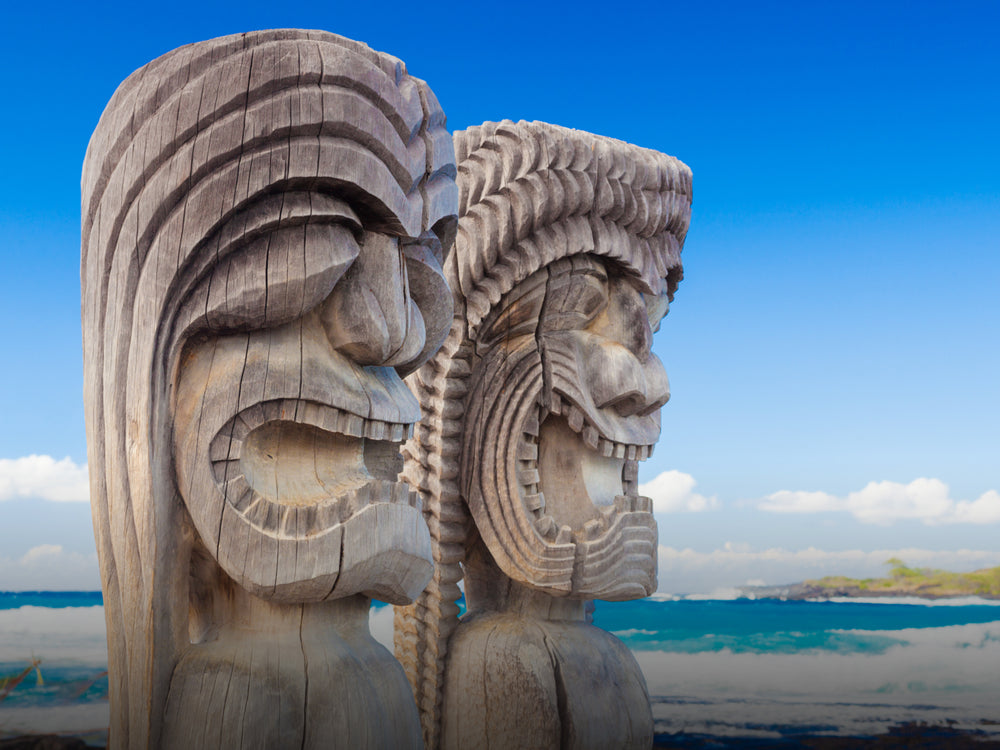Kona Soars To New Heights
Can the Industry Sustain Itself?
by Les Drent

Luis Cisneros - milling coffee at Bay View Farm in Honaunau. photo credit: Les Drent
The new numbers now surrounding the Kona coffee industry are staggering. It was only 10 years ago that Kona coffee acreage dropped to a mere 1,200 acres as the name “Kona Coffee” was becoming more of an icon throughout the coffee crazed world than the actual prized coffee bean from Kona.
While the last decade of the twentieth century for Kona coffee was marred by counterfeiting, scandals, federal indictments, and million dollar class action law suits, it is becoming more and more evident that this age old industry is turning over a new leaf and propelling itself to new heights. Coffee acreage in Kona is now estimated at nearly 3,000 acres and is expected to continue growing as the reputation of 100% Kona coffee and its appeal spreads.
Within the next two years coffee production in Kona will likely reach 18 million pounds of raw coffee cherry placing a 13.5 million dollar price tag on the annual Kona coffee crop if current cherry prices can maintain themselves. When milled and graded an estimated 26 million dollars will circulate throughout the green coffee industry and an estimated 60 million dollars will be spent by customers buying roasted Kona coffee.
While numbers like these pale in the face of serious coffee producing countries like Brazil and Colombia, their meaning is much greater when considering the small farmer in Kona and the huge effect this is having on the small 20 mile stretch of land on the Big Island known as the Kona Coffee Belt.
If anything has been learned by history these numbers should really surprise no one. At the turn of the twentieth century Kona coffee boomed to only see itself collapse before soaring again to 6,000 planted acres during the 1950’s.
These busts and booms throughout Kona’s long coffee history have many old time farmers holding fast to their belief that little future security can be found in growing Kona coffee. The big question still remains. Can a sustainable future finally be found in the midst of this new boom?
Many in Kona believe that it can but it will take much more than just growing great coffee. The road to sustaining the coffee economy relies heavily on the marketing of 100% Kona coffee.
Today farmers and millers have an advantage that their counterparts didn’t have in the past. Technology and enhanced communication systems have linked many customers to the direct source of their coffee and eliminated the need for the middle man. In the past this middle man or coffee broker served to only muddy the waters between customer and supplier and all too often jeopardized the purity of Kona coffee being delivered to the public. Ultimately it was the reputation of Kona coffee that was bastardized and the customer who was cheated out of the pure thing. While there are many reputable coffee brokers who deal in Kona coffee recent quality assurance programs have helped to eliminate those who are not playing by the rules. It’s still best for customers to know personally who they are buying 100% Kona coffee from. A personal relationship and running dialogue with your source is worth its weight in gold.
Realizing that the amount of money being controlled at the roasted and green end of Kona coffee is greatly disproportionate to the amount being generated at the raw coffee cherry end it is imperative that the growth of Kona coffee production is paralleled by the direct sale of roasted coffee. More dollars coming directly to Kona will enhance the economic and social welfare in the region and also allow farmers and millers to make decisions about where and how this coffee is sold. For most these are very important factors in upholding the gourmet reputation and purity of Kona coffee. And believe it or not they are also issues widely discussed among industry leaders.
Farmers planting new coffee should be aware of the volatile and diverse market surrounding Kona coffee and realize that their success should not rely solely on selling their coffee cherry to the processors. While coffee cherry prices rose to one dollar and seventy five cents per pound in 1998, this past season the price dropped to seventy five cents per pound. That should be evidence enough to understand that the cherry market is subject to huge sways. The price escalation of 1998 was the result of processor competition not mother nature or the world coffee market.
Kona Coffee Cherry. photo credit: George Yasuda
Despite the erratic ups and downs of the cherry market it is the opinion of many in Kona that acreage should continue to be expanded but only at the rate of reasonable demand for roasted coffee not cherry. Similar to investment planning it is wise to keep diverse when investing your money. Such is the case with Kona coffee and a sustainable future in farming. Achieving a customer base on the mainland for green and roasted coffee and not relying solely on what the mills are offering for raw coffee cherry will only help to protect the farmer in the event of a local market collapse in cherry prices.
At a cost of thirty five cents per pound to have coffee picked and an average of ten cents per pound for orchard maintenance that includes pricey fertilizers there is only a current margin of thirty cents per pound to capitalize on before taxes. All the more reason growers must find a way to capitalize on green and roasted sales where profits can soar to as much as three hundred percent. Capturing that roasted market and keeping more dollars in Kona will be the key to success for this industry. Then and only then will a sustainable and more secure future be in hand for those growing Kona coffee.
In the spirit of growing Kona coffee Coffee Times is lucky to have as a new advertiser Tiare Lani Coffee, owned and operated by George and Linda Yasuda of Holualoa. Outside of raising world class Kona coffee their services include expert consultation on growing Kona coffee.
This is the first article relating to growing Kona coffee that we have published in Coffee Times and I’m hoping we can get George to contribute more articles relating to the subject in future issues. I’m sure both locals and visitors alike will enjoy reading and learning about what goes into growing Kona coffee.
The old style coffee mill at D. Uchida Farm.
The undernourished Kona Coffee tree has no place in George Yasuda’s orchard.
Often, this tree, famous for its gourmet bean, looks a little scrawny with branches bearing widely spaced cherry clusters.
It’s mostly painted or photographed that way, too.
Yasuda, agricultural consultant for Tiare Lani Coffee and coffee researcher, believes the Kona Coffee tree has yet to be fully recognized in its truest, healthiest state.
The tree giants at Yasuda’s new orchard in Kainaliu stood as much as 14-feet tall after 2 1/2 years of growth. Today, their thick trunks send out strong branches with dark-green leaves and closely clustered cherries. The result - higher yields, quality and bigger beans.
It’s this kind of coffee tree that Yasuda, 43, of Holualoa, strives to see growing everywhere in Kona. “It’s just a matter of understanding plants and their needs,” Yasuda said in an interview. “With proper care, anyone can have trees living up to their full potential.”
The Kona native has put his theories and education to work in coffee orchards throughout Kona. Yasuda has consulted with upwards of 120 farmers in the past twenty-one years, helping them start as many as 1,500 new acres of coffee and several nurseries producing thousands of trees.
George Yasuda (left) with Burt Rames harvesting his giant Kona coffee trees planted only three years ago.
Yasuda said his orchards are producing well above the industry average of 6,000 pounds of cherry per acre, a figure from a Hawaii Department of Agriculture publication.
This current harvest season, Yasuda said his mature orchard in Holualoa, which is planted “old-style,” or not in rows, will bear 13,000 pounds per acre.
His new orchard in Kainaliu bore 9,000 pounds per acre in 1998-99, when the trees were 2 years and three months old. The same trees a year later will bear approximately 11,000 pounds per acre, he said. Yasuda estimates that healthy mature Kona Coffee trees should bear anywhere from 12,500 pounds per acre to 14,500 pounds per acre, depending on elevation and weather.
Nurseries Vs. “Pulla Pulla”
Yasuda encourages new farmers to grow coffee from seed in nurseries, versus the old-style, “pulla-pulla” method, in which young coffee plants, sprouting where they fall, are pulled out of the ground and replanted.
“When you start your trees in the nursery, you have more control over the quality of the trees that will become your orchard for the next 100 years plus,” Yasuda said. “From the nursery stage, trees do better overall. “Pulla-pulla” tends to produce after 3 or 4 years, and not very consistently.”
Using the horticultural techniques he’s perfected since working in his family’s coffee land as a young boy and later as an agricultural college student and researcher at the University of Hawaii’s experiment station, Yasuda’s orchard surpassed his own expectations.
“We had to replace maybe 2% of the trees in the first year,” he said. “That’s pretty low compared to other farming styles.”
Yasuda’s consulting has helped many farmers, including Jim and Vicky Wickersham of VikiWiki Coffee Co. in Kainaliu. They said George recommended they buy their farm when no one else would.
“This 9-acre farm was pretty far gone at the time - even with its existing coffee trees,” said Vicki. “They told us to forget it.”
“George took one look and told us it was an excellent opportunity,” added Jim. “We’ve followed his advice, and only his advice, ever since. Next year, we will double our cherry production in weight.”
Joe Santimer, owner of Hookena Nursery, which sells more than 40,000 coffee trees a year, said it was Yasuda’s consulting advice that helped his nursery become one of Kona’s biggest and better coffee tree nurseries.
“He knows the answers,” Santimer said in a recent interview. “Without George we would not be where we are today. If I ask him a question, he doesn’t have to go look it up. It’s right there on the tip of his tongue.”
Following are brief explanations of Yasuda’s techniques which include: proper land preparation, spacing of trees, stock selection, fertilization, pruning and a theory that could decrease widespread concern about nematodes, the wormlike insect known to nibble at the coffee tree’s roots and, eventually, kill it.
Land Preparation
Yasuda said a critical first step in planting a new coffee orchard is land preparation. Choosing a reputable large equipment operator with experience in agriculture is important, he said.
“If you cut corners at this juncture, you could end up running in circles later on,” Yasuda said. “A good bulldozer operator knows that you can’t mix topsoil with subsoil, and in Kona, especially, you have to rip the rock so the root systems have room to grow.”
Yasuda always encourages developers to bulldoze around native Hawaiian trees. The ‘ohi’a trees in Yasuda’s orchard continue to support native Hawaiian birds and act as a beautiful shade canopy for the coffee trees.
Spacing
Yasuda recommends spacing new orchards in the following way - generally, depending on elevation, he said it is best to put 6 feet between the trees and 12 feet between the rows, all planted north to south. He said this step nearly always assures a farmer he will get trees with closely clustered cherries.
“This spacing brings optimum yields and quality coffee,” Yasuda said. “Putting coffee trees closer together makes them lanky and vegetative. Plus, it’s more expensive to take care of with no increase in yields in the long run.”
Stock Selection
While most Kona Coffee trees are of the Guatemalan variety, Yasuda said it is important to choose seed stock carefully. He said one must either get seed stock from proven tree parents or from nurseries using quality stock.
“You wouldn’t grow an orange tree from an orange that didn’t taste good,” Yasuda said. “Knowing what strain the coffee comes from will make all the difference in the taste.”
Fertilization
Bottom line — fertilizing is an extra cost, but Yasuda said the benefits far outweigh the added expense. Yasuda’s optimum fertilization program costs approximately $800 per acre, per year. However, he said he would recommend less if a farmer couldn’t handle the cost. He said even $400 per acre, per year is helpful to an orchard.
“Industry-wide, farmers are getting about an average 60 bags of cherry per acre,” Yasuda said. “If you can get 110 to 140 bags, the coffee will easily pay for the materials.”
“Your fixed costs will always be there - land taxes, herbiciding, mowing, etc. - but if you can increase the yield, your net profit will be higher.”
Pruning
One self-taught technique that Yasuda uses with great results is the pruning of coffee trees in their 1st and 2nd years. After about a year of growth, when most consider the trees young and in need of their branches, Yasuda prunes heavily.
“By the second year, the trees have as many as 5 verticals,” Yasuda said, referring to the shoots that grow straight up and become the major coffee-bearing branches. “Obviously, a tree with 3 to 5 verticals will produce more coffee than a tree with one.”
Nematodes
Yasuda has planted new orchards in locations known to have nematodes, although many advised him not to do it. Yet, the trees have flourished and show no sign of nematode destruction. Based on what he’s experienced, Yasuda believes a healthy coffee tree will successfully battle nematodes.
“It’s just like the human body and a virus,” Yasuda said. “When the body is weak, the virus attacks, and the body is nearly defenseless. My experience is that healthy coffee trees continue to grow, repair the damage, and the tree life expectancy is normal. (How to battle nematodes successfuly is an ongoing campaign and the theories surrounding the subject are not proven practices as of yet.)
Readers may submit editorial comments to any of our stories by sending an email to les@lbdcoffee.com. We would be happy to attach your comments and feedback to anything we publish online. Thank you for your interest.
Story appeared originally in Coffee Times print magazine and appears online for archival purposes only. Any use or reprinting of these stories without the expressed written consent of the author is prohibited.



